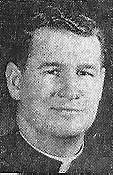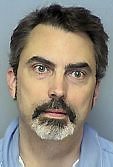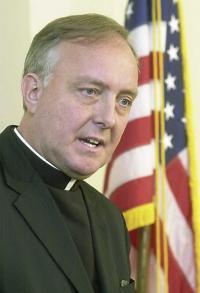Whistleblower Accuses Twin Cities Archdiocese of Host of Misdeeds Related to Clergy Abuse
By Emily Gurnon
The archdiocese has addressed some of the issues Haselberger raised by implementing recommendations of the Safe Environment and Ministerial Standards Task Force, which was convened last fall, Cozzens said. 'MONTHS OF HARASSMENT' Haselberger said she endured "months of harassment, threats, and intimidation" before she resigned April 30, 2013. The state Department of Employment and Economic Development concluded she "resigned for good reason caused by my employer, because I felt that I could no longer work for an organization that was not cooperating fully with investigations into illegal activities within the organization," she wrote. On two occasions, she called a friend who worked for the Ramsey County attorney's office and reported what she knew -- feeling she was "out of options" with the church. Once was days after the archdiocese learned of the accusations that the Rev. Curtis Wehmeyer had abused two boys of his parish in his personal camper, which was parked in the Blessed Sacrament parking lot in St. Paul. He is now serving a five-year prison sentence. The second time she called prosecutors was to report that the archdiocese possessed pornographic images from the Rev. Jonathan Shelley's computer but had failed to turn over results of a consultant's investigation to police. Police later determined that the images did not depict minors, though Haselberger pointed out that Shelley refused to give officials other computers he owned. MCDONOUGH FAVORED LIGHT APPROACH For years, McDonough was the main point person for the archdiocese on child sexual abuse.
He gave detailed testimony in his April 16 deposition about archdiocese policies and practices regarding sexual abuse, which he had put in place beginning in the late 1980s, Haselberger said. She always perceived "a certain amount of pride" in McDonough about the work he did during those early years. But she believed he struggled to accept that the church "largely repudiated" those policies and procedures in 2001 and 2002. The year 2002 saw the adoption by U.S. bishops of the Charter for the Protection of Children and Young People, which included requirements that all reports of child sex abuse be forwarded to civil authorities and that dioceses be transparent with the public about abuse.
Another document, the Sacramentorum Sanctitatis Tutella (SST) of 2001, advocated for dismissal of clergy who abuse children. But McDonough wasn't about to change the way he dealt with offending priests, Haselberger wrote. "My experience of working with Father McDonough as well as my review of his work since 2001 led me to conclude that while he occasionally gave lip-service to these principles, he never accepted them and often failed to apply them," Haselberger wrote. Instead, he favored a softer approach with abusers. MCDONOUGH OPPOSED DISMISSING OFFENDING PRIESTS Haselberger reviewed a letter shortly after she became chancellor that had been sent by Archbishop Flynn to Cardinal Angelo Amato in Rome. Amato was then the secretary for the Congregation for the Doctrine of the Faith, which evaluates disciplinary action against clergy. The letter explained to Amato that the archdiocese "was not employing the prescribed processes against priests who had sexually abused minors, preferring instead to secure the priests' 'voluntary compliance' with the restrictions of the Charter... as that means of proceeding was 'less harsh' and 'less punitive' towards the offending priests," Haselberger said. She experienced McDonough's reluctance to apply the stricter rules in the case of a priest who was being dismissed for sexual misconduct with several women, one under 18, among other reasons. (The priest's name is redacted in the affidavit -- as are several others -- because they are among the 48 that the archdiocese has argued in court should remain secret.) While they were waiting to give the priest the bad news, Haselberger mentioned that she had the decree of dismissal from the Congregation for the Doctrine of the Faith. McDonough asked if he could see it. She told him it was the standard document used with priests who were being defrocked. "It was at that point that he told me that this would be the first such decree that he had seen," Haselberger wrote. "I remember being stunned, and unable to comprehend how the vicar general of an archdiocese like St. Paul and Minneapolis (home to infamous offenders like James Porter and Robert Kapoun) could go until 2006 -- four years after the adoption of the Charter -1/8and accompanying document-3/8 -- without having seen a decree of dismissal." McDonough explained: Dismissal wasn't the right thing for the Church, Haselberger remembered him saying. He told the offending cleric he was "a priest forever" in his heart. The archdiocese has never disclosed that former priest's name to the public, Haselberger said. FEAR OF LITIGATION In fact, McDonough didn't like the idea of making lists of accused priests, Haselberger wrote. "Father McDonough was advising against keeping lists of accused priests because of the extreme likelihood that such lists would be sought in litigation resulting from the probable passage of the Child Victims Act (which has since been passed)," she wrote. In a footnote, she continued, "the only argument that I ever heard against publishing the list that did not involve the words 'litigation' or 'Jeff Anderson' was that doing so would be unfair to the 'dead guys' who may have been falsely accused." As for the living priests, many enjoyed years of active ministry -- and anonymity -- after accusations of abuse, Haselberger wrote. The Rev. Michael Keating of the University of St. Thomas was one. A woman sued Keating last year, alleging that he molested her when she was 13. The archdiocese had known of the allegations, and those of three other women or girls, since 2006, according to internal memos. His case was examined by the archdiocese's Clergy Review Board, and it made a "determination" which ended the inquiry. But the review board is an advisory body, "not empowered to investigate or reach a determination," Haselberger wrote. She believed they were provided with no documents or files in making their "determinations." "The fact that the archdiocese continued to use the review board in these ways again indicative of the Archdiocese of St. Paul and Minneapolis being out of step with the rest of the American Catholic Church, and counter to the expectations of the Holy See, after 2002," Haselberger wrote. 'STOP LOOKING UNDER ROCKS' Haselberger also criticized the archdiocese's practice of sending emails to individuals making reports of abuse, rather than visiting them in person. It was no way to treat potential victims, she said, and it contributed to her belief that when the archdiocese "investigated" something, "it was always done in such a way as to ensure that we concluded the investigation with less clarity than we began with." Furthermore, officials such as Eisenzimmer, the attorney, avoided looking at accused priests' files and discouraged her from doing so, telling her to "stop looking under rocks," she said. One priest whose file she examined was Gerald Grieman, who is now retired and living in Arizona. Eisenzimmer testified in a recent deposition that he believed Grieman had been examined by the review board. But it never had been -- though other dioceses had been told the review board was consulted and had cleared him. "However, to its credit, the Diocese of Phoenix was not satisfied with this, but demanded a copy of the review board's opinion," Haselberger wrote. That's when she discovered it didn't exist. LAIRD REFUSED TO READ REPORTS Laird, who served as vicar general after McDonough, also preferred to remain ignorant when it came to abusive priests, Haselberger said. She discovered that the proper disclosures had not been done in the case of the Rev. Joseph Gallatin, who had been a classmate of Laird's in seminary. Laird believed the alleged misconduct did not involve children. Yet documents in his file mentioned "the sexual nature of his contact" with a West Virginia boy and his "admitted sexual attraction to boys as young as 12," Haselberger wrote. She marked those passages with a highlighter. Laird refused to read the whole reports, saying he had been told there was no cause for concern, she wrote. "I literally followed Father Laird out of the building one evening with those highlighted documents in my hands, saying that if he didn't have time to read the whole documents, he could at least read the highlighted remarks. He refused." To Haselberger, Laird's behavior "epitomize(d) the archdiocese's cavalier attitude toward the safety of other people's children." OFFICIALS AVOIDED CONTACT WITH VICTIMS When the archdiocese did investigate allegations, the inquiries were less than aggressive, Haselberger said. Church officials hired the private firm Richard Setter and Associates for several investigations, including that of Richard Boyd, then a priest from the Diocese of Crookston who had previously been in the Twin Cities archdiocese. Setter had investigated him in 2003 "after parishioners raised concerns regarding then-Father Boyd's conduct with youth in his parishes," Haselberger wrote. He was returned to ministry after the investigation, but Haselberger urged it be reopened in 2005. Underage boys who were confirmation candidates were heard talking about how Boyd had pornography on his computer. (Twenty years earlier, Boyd had pleaded guilty to possession of child pornography in East Grand Forks, yet was returned to ministry.) In his investigation, Setter interviewed the parish secretary and other adult women. They figured what the boys had seen was Boyd's screensaver, which showed a photo of the priest in a Speedo swimsuit. "Several of the adult women interviewed believed that it was likely that the boys had seen the photo and mistakenly believed it was pornography," Haselberger wrote. "At no point during Mr. Setter's investigation did he speak with the confirmation students about what they had seen." Similarly, in an investigation of Grieman, Setter talked with "mainly female parish employees" but "did not contact any of the individuals who were identified by the victim as having served with him as altar boys at the same time that the abuse was alleged to have occurred, reportedly because Mr. Setter felt he did not have 'permission' to do so," Haselberger wrote. The boys were, by that time, adults. And Setter was asked to investigate a report that a computer belonging to Shelley, who worked at churches in Hugo and Mahtomedi, might contain child pornography. Setter concluded that the images were "borderline" child porn, but he did not report it to police, "nor did he investigate the previous accusations that had been made against Father Shelley," Haselberger wrote. Those included reports of Shelley "grab-assing" teenage boys, as Eisenzimmer described it, while he was in seminary. LAX MONITORING Those priests who were determined to have committed misconduct or abuse were, at times, placed on the archdiocese's monitoring program. But despite McDonough's contention that the program was "state of the art," Haselberger strongly disagreed. Having designed such programs for other dioceses and participated in seminars in which they were discussed, "I feel qualified to state unequivocally that the archdiocese's program was not 'state of the art,' nor was it even adequate," she wrote. Unlike other monitoring programs, McDonough's was a "probationary" model characterized by infrequent -- "often quarterly or less" -- meetings with the priests and heavily reliant on the priests' self-reports, Haselberger wrote. While the grave problems of priest misconduct were being ignored, Haselberger said, top officials focused their attention on other matters. Archbishop Nienstedt regularly sent angry memos to staff "on the most mundane of topics" such as leaving the garage lights on and Eisenzimmer's failure to wear a tie; Eisenzimmer called them "nastygrams," Haselberger said. Laird threw himself into a two-year remodeling project at the chancery, she wrote, turning nearly half the space devoted to archives and records to a new staff lounge and office space for a communications department he had expanded from a staff of one to, she believed, more than 20. Because there was now inadequate space for storage, Laird rented large commercial Dumpsters to get rid of records and archival material -- including the "irreplaceable and invaluable Sacred Music Collection from -1/8the old-3/8 Nazareth Hall," Haselberger said. Unable to convince Laird of its value, staff members staged a "black op" and moved the collection to another location without Laird's knowledge so that it could be preserved, she wrote. Her job as chancellor was not Haselberger's first with the archdiocese. In 2004, then-Archbishop Flynn appointed her to serve as a judge on the Metropolitan Tribunal, formerly known as the Marriage Tribunal. She also served as a victims' advocate for the archdiocese's Office of Advocacy/Commission on Women. PRIEST FATHERED CHILD, SERVED ON MARRIAGE TRIBUNAL It was in 2004, she said, that she first saw the archdiocese's "efforts to conceal from the general public the potential criminal acts of sexual misconduct by its clergy, and the injurious nature of such concealment" in the case of the Rev. Daniel Conlin. Conlin had fathered a child with a married woman while pastor at St. Columba Church in St. Paul. Another member of the tribunal took her aside one day and told her of the situation. The employee, Eugene Burke, "stated it was believed by some that Reverend Conlin had been providing counseling to (the woman) regarding her marital difficulties either at the time or before she became pregnant." Minnesota law makes it a crime for clergy to have sexual contact with a person to whom they are providing "religious or spiritual advice, aid or comfort." Conlin said in a Pioneer Press interview last year that what he did was not criminal. Haselberger wrote that she was concerned that Conlin's job at the tribunal would bring him "into contact with more vulnerable women experiencing marital distress." 'FINAL STRAW' After she left her job with the tribunal, Haselberger was determined not to come back as long as Flynn and his administration led the archdiocese. She applied for the job of chancellor after learning that Nienstedt had accepted McDonough's resignation as vicar general. She wasn't told during her interviews that McDonough would remain the "point person" for clergy misconduct as Delegate for Safe Environment. When she learned about it several weeks into her new job, it "immediately caused me to reconsider my decision to accept the job offer," Haselberger wrote. Still, she stayed on, hoping to help fix the "very serious problems" that she had identified. But that effort was fruitless, she said. After one of the many frustrating meetings, this one concerning Jon Shelley, a co-worker who was friends with Eisenzimmer described him as "scared" of acting on the images found on Shelley's computer, Haselberger said. She knew the feeling. "I was scared both times that I picked up the phone and called the Ramsey County Attorney's Office," Haselberger wrote. "But, I am also willing to bet that the boys that found themselves in Wehmeyer's camper when he started to undress were scared. ... No matter how scared we (adults) were, we had an obligation to do our jobs and protect those kids, as the bishops had promised we would, even if doing so meant that we had to take a deep breath, and, to borrow a line from Shakespeare, screw our courage to the sticking-point." She was asked many times last fall whether she believed that Nienstedt should resign. She said no, at first. But her view has changed since being interviewed this spring by attorneys at Greene Espel regarding allegations of inappropriate sexual conduct by Nienstedt with seminarians, priests and other adult men, Haselberger said. The archdiocese hired the law firm to investigate. One of the issues under investigation, she was told, was "whether the archbishop had a personal and distinctly unprofessional relationship with Father Wehmeyer that may have influenced the archbishop's decision to disregard my warnings about Father Wehmeyer's prior conduct and the risk he posed," she wrote. The "final straw" for her, Haselberger wrote, was when Nienstedt told an Edina church congregation in December that he believed the issue of clergy abuse had been taken care of by the time he became archbishop. That, Haselberger said, was a boldfaced lie. "That was really when I abandoned hope that this situation could be resolved by the present administration, by which I mean not only the archbishop, but everyone else who has been involved in this ongoing debacle," she wrote. The Rev. Thomas P. Doyle, a canon lawyer in Vienna, Va., with more than 30 years of experience in priest sex abuse issues, said he would not be surprised if Nienstedt is asked "fairly quickly to resign." "If he had any decency, he'd go right now," Doyle said. "What I see happening in Minneapolis/St. Paul is a fragile house of cards that they have constructed over the years is falling apart." Emily Gurnon can be reached at 651-228-5522. Follow her on Twitter.com/emilygurnon. Contact: egurnon@pioneerpress.com
|
.
Any original material on these pages is copyright © BishopAccountability.org 2004. Reproduce freely with attribution.


